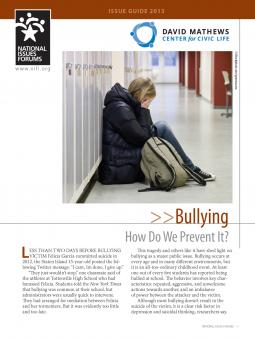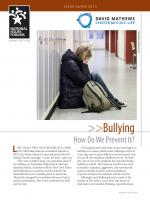
How Do We Prevent It?
Bullying occurs at every age and in many different environments, but it is an all-too-ordinary childhood event. At least one out of every five students has reported being bullied at school. The behavior involves key characteristics: repeated, aggressive, and unwelcome actions towards another, and an imbalance of power between the attacker and the victim.
Helping the bully change is also part of many successful anti-bullying strategies. Often, bullies are blind to the feelings of others. They are aggressive, perceive the actions of others as threatening when they are not, and avoid responsibility for the consequences of their actions. Yet their aggressive behavior doesn't just hurt victims—bullies will suffer, too, if they don't change.
But bullying is not just a family issue. Workplace bullying costs businesses time and money and leads to higher employee turnover. If communities addressed bullying in a serious way through civic organizations and business groups, the threat of intimidation and harassment could go down for everyone—young and old alike.
The guide presents three possible options for deliberation:
Get Tough on Bullying
Bullying incidents are reaching epidemic proportions. Bullying is unacceptable. It must be treated with zero tolerance. Increased reports of bullying in our schools demand that teachers, principals, and school districts do more to help prevent bullying and provide tougher consequences for those who engage in it. We must ensure that school district anti-harassment policies and student codes of conduct are in place and strictly enforced.
Equip Schools to Address Bullying
Not every young person understands what constitutes bullying and how to respond to it. We need to educate our children about bullying and effective ways to deal with it. Many feel powerless as victims or as bystanders. At the same time, many bullies do not understand the effects of their actions. The lines between victims and bullies often become blurred when circumstances change or victims retaliate. We should create supportive, enriching school cultures that equip teachers and students to address the root causes of bullying.
Engage the Community and Parents
Bullying is a widespread behavior that is not limited to educational settings, so schools should not bear the entire responsibility for addressing what is a public issue. Parents and the community should talk about bullying and discuss ways of preventing it. A lot of bullying and violent behavior begins in the home. We must reach out to young people, some of whom do not have supportive home environments and need community help.


